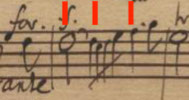Kinetic relationship between arsis and thesis, and the three levels of metrical structure
(V2aT4)
Movement imagery stimulates all the stages of a performer’s interpretation process, from a 'silent' reading of the score to the actual performance. My iconic beat box method functions at the 'in-time' articulatory level, while the arbitrary dance terms define the general characteristics of the individual movement patterns. At the structural level of phrasing, I was searching for an overall kinaesthetic translation between the physicality of dance movements and the large scale forms of the musical structures.
What musicians understand as opposing forces (for example, between: upbeat and downbeat; moving forward and dragging; moving lightly or heavily) can be translated into terms used in dance, such as 'arsis' and 'thesis'. As Meredith Little and Natalie Jenne remind us, the term 'rhythm' was in the earlier times ‘used as a verb. It is an activity, not a thing’ (Little & Jenne, 1991, p. 16). The kinaesthetic relationship between arsis and thesis denotes the basic principle of movement as a sequence of impulses and relaxations. This relationship is applicable on all levels of musical structure, from articulation, through motivic patterns, to the structuring of musical phrases, sections, and movements. The single step-unit will always retain its arsic and thetic identity even when we 'zoom out' to the higher structural level of a series of step-units, or to even larger phrase structures.
The structuring of single bow-strokes or dance steps into units and phrases follows a similar procedure as the construction of a sentence in speech. When I pronounce the words ‘dolce’ and ‘vita’ separately, the arsic energy on the first syllables of both words will be identical. But if I arrange these words into the phrase ‘dolce vita’, the arsic and thetic relationship will materialize on the level of the phrase. This will reshape, but not eliminate, the syllabic arsic-thetic relationship inside the words. The accent on 'dol-' will bounce towards the accent on 'vi-', organising the four syllables into a single unit with one arsic and one thetic accent.
Similarly, in a bow-stroke, I connect the separate notes into patterns, and patterns into phrases. The identity of a single pattern remains intact, although it needs to be reshaped to correspond the larger arsic-thetic hierarchical relationship of the phrase [1].
Little and Jenne (1991) identify three levels of metric structure: beat, pulse and tap (pp. 17-18). Through the arsic and thetic structure at the beat level, the dance structure can be recognized, as the beat level of metrical structure coincides with the dance steps. The Courante structure is revealed on the beat level of half notes. A pattern comprising three half notes constitutes a measure, which will correspond to a step-unit (i.e. temps de courante).

Ex. 1 The red markings illustrate the metric level of the beat.
The beat level can be subdivided into a pulse level. In the case of the Courante the pulse level corresponds to quarter notes. Little and Jenne observe that ‘the pulse level is the lowest level that can be syncopated […] and which may be replaced by a dotted rhythm’ (Little & Jenne, 1991, p. 17).
A subdivision of the pulse level is the tap level. A tap is ‘the smallest unit that can make an essential contribution to the perceivable rhythmic hierarchy. Subdivisions of taps are not of rhythmic significance but are ornaments or melodic flourishes’ (Little & Jenne, 1991, p. 17). In the Courante in ex. 1 above, the eighth-notes function on the tap level. Little defines the tap level as the lowest level that can be dotted (or played inégale) or articulated, as the ‘articulation patterns given in manuals which describe the bowing, tonguing, or fingering of baroque instrumental music never use a level lower than the tap’ (p. 17).
Summarizing their discussion connected to the definition of three metric levels, Little and Jenne observe that the beat level (and, exceptionally, the pulse level) coincides with the harmonic changes, as well as with the syllabic distribution of the lyrics, and, not least, the dance steps.
In Ups and Downs, I apply the observed structural relationships (musical notation, harmonic structure, dance steps) into my movements in performance. I translate the beat, pulse, and tap levels into the structure of my body movements. A beat level that defines the structure of a musical measure, which in turn corresponds to a step-unit of a dance structure, is thereby materialized in the kinaesthetic relationship between body and floor; the subdivision of the beats into the pulses is mirrored in the interplay of the sound-producing movements in the context of expressive body movements; finally, the tap level corresponds to the articulatory bow action.
By translating the inherent kinaesthetic energies of dance directly into my playing body, I attempt to transcend the historical specifics of dance forms as captured in musical score, historical information, and dance steps. The performance is not just a summary of the score and the available documentation of historic performance practice, but rather an attempt to reach beyond the fixed text, towards the very source that the score attempts to capture.
An intriguing comparison between the baroque and romantic aesthetic strategies can be drawn here. While the baroque performer builds up a larger phrase by organising the small distinct patterns (based on dance steps or on the pronunciation of words), the romantic instrumentalist or singer tends to sacrifice the smaller patterns and words in order to enhance the smoothness and continuity of the larger phrase. A single bow-stroke or a naturally accentuated syllable in a word is considered a hindrance in a Bruckner phrase, to be eliminated by a good technique; while for a baroque performer it is precisely the interplay of the small patterns that nourishes the living architecture of a phrase.
Note 1